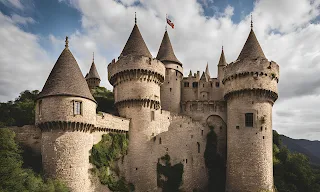Castle architecture is a captivating blend of function, artistry, and historical significance. These monumental structures, built to withstand sieges and symbolize power, continue to fascinate people worldwide.
What is Castle Architecture?
Definition and Purpose
Castle architecture refers to the design and construction of fortified buildings used primarily for defense, governance, and residence. Castles were strategic military structures and homes for nobility, combining practicality with grandeur.
Historical Context and Evolution
Castles emerged during the medieval period, primarily in Europe, and evolved over centuries to meet changing military needs, technological advancements, and cultural influences.
The Origins of Castle Architecture
Early Fortifications in Ancient Civilizations
The concept of fortified settlements predates castles. Ancient civilizations, such as Mesopotamians and Egyptians, built walled cities and citadels to protect against invasions.
The Rise of Medieval Castles in Europe
Medieval castles began appearing in the 9th and 10th centuries as a response to invasions by Vikings, Magyars, and other groups. These early castles were typically constructed from wood and earth.
Influence of Byzantine and Islamic Designs
Byzantine and Islamic architecture influenced castle design through cross-cultural exchanges during the Crusades, introducing advanced defensive techniques and artistic elements.
Key Features of Castle Architecture
Defensive Walls and Moats
Thick stone walls and surrounding moats provided the first line of defense, deterring enemy attacks and making sieges challenging.
Towers and Battlements
Towers offered vantage points for archers, while battlements provided cover for defenders during attacks.
Gatehouses and Drawbridges
Gatehouses controlled access to the castle and were often equipped with portcullises and murder holes. Drawbridges added another layer of security.
Keeps and Great Halls
The keep, or central stronghold, served as the last line of defense and residence for the lord. Great halls were used for gatherings, feasts, and administrative purposes.
Courtyards and Bailey Layouts
Inner courtyards, known as baileys, housed auxiliary buildings, workshops, and stables. They also provided open space for training and communal activities.
The Different Types of Castles
Motte-and-Bailey Castles
These early castles featured a wooden or stone keep on a raised earthwork (motte) and an enclosed courtyard (bailey) below.
Stone Keep Castles
Stone keeps replaced wooden structures for greater durability and protection, becoming the hallmark of medieval castle design.
Concentric Castles
Featuring multiple layers of defensive walls, concentric castles were designed for maximum security.
Transitional Castles
These castles combined elements of earlier designs with innovations like round towers and improved fortifications.
Palatial Castles
As military needs diminished, castles became more ornate and focused on comfort, resembling palaces.
Iconic Castles Around the World
Windsor Castle
The longest-occupied castle in the world, Windsor Castle serves as a residence for the British royal family and a symbol of continuity.
Neuschwanstein Castle
This fairy-tale castle in Germany, with its picturesque setting and romantic design, inspired Disney’s Sleeping Beauty Castle.
Himeji Castle
Known as the "White Heron Castle," Himeji Castle in Japan is a masterpiece of feudal Japanese architecture.
Château de Chambord
This French Renaissance castle blends defensive features with opulent design, reflecting the transition to palatial architecture.
Edinburgh Castle
Perched atop an extinct volcanic rock, Edinburgh Castle is a prominent Scottish landmark with a rich history.
The Role of Castles in Society
Military Strongholds
Castles were vital for defending territories, housing soldiers, and withstanding sieges.
Symbols of Power and Wealth
Owning a castle signified authority and status, often reflecting the lord’s wealth and influence.
Centers of Administration and Governance
Castles functioned as administrative hubs, where taxes were collected, justice was dispensed, and policies were enforced.
Homes for Nobility
Beyond their defensive purpose, castles provided luxurious residences for noble families and their retinues.
The Evolution of Castle Design
Transition from Wooden to Stone Structures
The shift from wood to stone construction in the 11th century improved durability and defense.
Innovations in Defensive Architecture
Features such as angled walls, round towers, and machicolations enhanced castles' ability to withstand attacks.
Decline of Castles and Rise of Palaces
The invention of gunpowder and cannons rendered traditional castles obsolete, leading to the rise of unfortified palatial residences.
Construction Techniques of Castles
Materials and Resources Used
Builders used locally available materials like stone, timber, and lime mortar, often transporting them over long distances.
Skilled Labor and Craftsmanship
Castle construction required skilled stonemasons, carpenters, and engineers, many of whom passed their knowledge through generations.
Challenges in Medieval Construction
Medieval builders faced logistical challenges, harsh conditions, and the need to adapt to the local terrain.
Preservation and Modern Uses of Castles
Restorations and Historical Preservation
Efforts to preserve castles involve meticulous restorations, combating the effects of time, weather, and human activity.
Castles as Museums and Tourist Attractions
Many castles have been transformed into museums, offering visitors a glimpse into medieval life and architecture.
Castles in Modern Media and Pop Culture
Castles feature prominently in films, literature, and games, continuing to inspire fascination and creativity.

